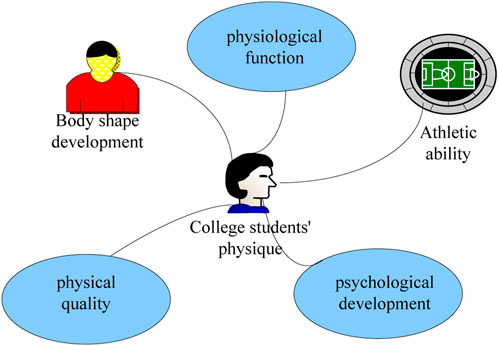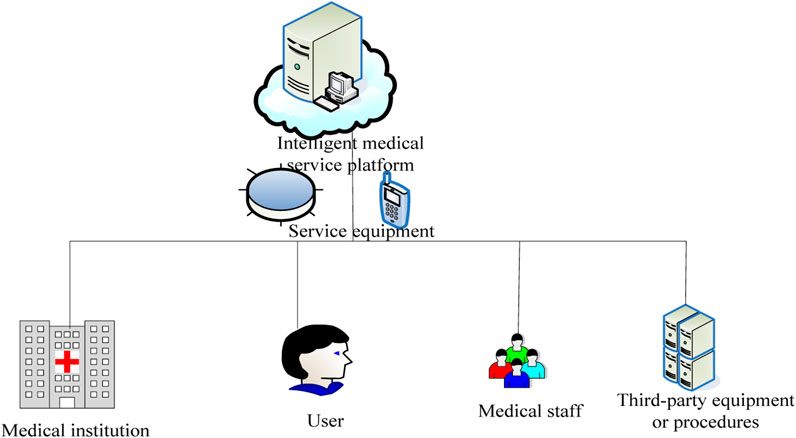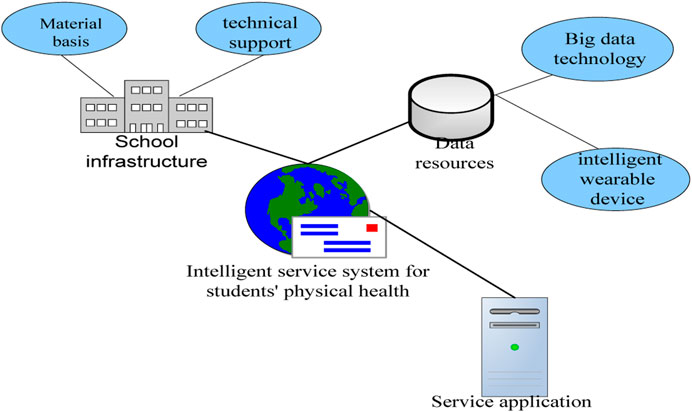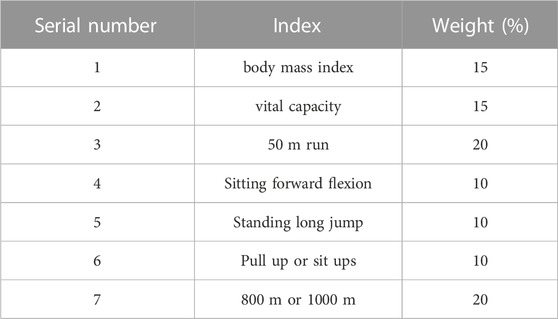- School of Physical Education, Harbin University, Harbin, Heilongjiang, China
Due to the rapid changes in current technology, machine learning and high-performance computing in medical applications also usher in new development opportunities. They are widely used in medical data analysis, diagnostic decision-making, disease prediction, disease assisted diagnosis, disease prognosis evaluation, new drug research and development, health management, and other fields. The impact of medical application on daily life is also increasing, which makes the use of intelligent medical service decision-making more extensive. However, with the continuous improvement and development of the population’s physical fitness, the physical fitness of university students is deteriorating. Physical decline has become a common concern. Therefore, it is of great significance to investigate the physical condition of college students and find a more suitable method to promote the physical health of college students. It helps college students better engage in learning and life, enabling them to adapt to work faster and better meet the current social development needs for college students’ physical fitness. For this reason, this paper proposes the idea of building a smart supervision platform for college students’ physical health through smart medical service decision-making. Through empirical research on this platform, it is found that the method of building the platform proposed in this paper is more conducive to the improvement of college students’ physical health. The excellent grade of freshmen in this platform is 5.4% higher than that of the traditional platform, and the excellent grade of sophomores in the test is 6.31% higher than that of the traditional platform, the excellent grade of college students’ physical health test on this platform accounts for a higher proportion. The platform provides corresponding personalized sports programs through real-time monitoring of students’ physical health, so as to realize teaching students in accordance with their aptitude, scientifically guide students’ physical exercise, and accurately improve students’ physical health. Meanwhile, research on the use of big data in sports has also led to advances in machine learning and high performance computing for medical applications, which improves their shortcomings.
1 Introduction
Due to technological advances, the current medical equipment has also been better developed, and machine learning and high-performance computing in medical applications are also more widely used. Intelligent medical service decision-making based on medical application also has good development opportunities. The economic level of today’s society has increased. The physical development level of urban and rural students has continued to grow, but their physical fitness has begun to decline. Studying the physical fitness of college students is not only the key to improving their academic performance, but also helps them improve their overall quality, enabling them to have stronger willpower and resilience. This is conducive to the comprehensive promotion of quality education, protecting students’ health, and playing an important role in cultivating the talents needed by society. Therefore, it is necessary to conduct in-depth research on the physique of college students.
Monitoring and evaluating the physical health of college students is extremely important for promoting the innovation and development of physical health. Intelligent medicine can centralize the storage and management of collected data, achieve data sharing and deep utilization. It can also provide long-term, rapid, and stable health monitoring and diagnosis services for sub healthy people at lower costs, reduce the risk of illness, and indirectly reduce the demand for scarce medical resources. As an important way to ensure physical health at present, smart medical service has unique advantages in building a smart supervision platform for college students’ physical health. Therefore, on the basis of theoretical discussion of smart medical services, this paper draws on the current traditional intelligent supervision platform for college students’ physical health, thus building the latest intelligent supervision platform, and verifies the feasibility and overall performance of the platform and draws the corresponding conclusion. The empirical results show that the platform is highly operable and scientific, and can provide comprehensive services to individual or group college students, thus making college students’ physical health work more scientific and intelligent. This paper aims to provide more theoretical basis for the improvement and evaluation of college students’ physical health through the research on the construction of intelligent supervision platform for college students’ physical health through intelligent medical service decision-making. At the same time, it is hoped that the research on intelligent medical service decision-making can broaden the application scope of machine learning and high-performance computing in medical applications and make it better developed.
Many scholars have discussed the study of college students’ physical fitness from different angles. Moon Jeong Eun conducted a convergence study on the factors affecting the physical fitness of university students. Through investigation, he found that the enhancement of subjective perception, health awareness and breakfast habits were essential to improve physical fitness. Therefore, it is necessary to formulate a health promotion plan according to the factors affecting physical fitness, and analyze its application effect [1]. Barnett Tracey Marie studied the physical and mental health experiences of African American college students. He said that the transition from family life to college life would lead to changes in diet and physical activity behavior, which would also make the physical fitness of African American college students worse and increase the risk of disease [2]. Chen Xiaobin studied the relationship between the body mass index and the healthy physique of Chinese university students. Through his research, he found that the relationship between the body mass index and the physical fitness index of college students was non-linear. The performance of underweight, overweight and obese students in body mass index was worse than that of normal weight students [3]. Wang JunLi studied the relationship between physical fitness and sports activities of Chinese university students. He analyzed the potential health risks of college students’ lack of physical exercise. According to the experiment, compared with students who actively participate in exercise, college students who lack exercise have a higher risk of obesity. University students should exercise regularly to improve their physical fitness [4]. These scholars’ discussion on college students’ physical fitness can enrich the research content on college students’ physical fitness to a certain extent, but there are also shortcomings. Scholars’ research on college students’ physical health mostly focuses on factors that affect their physical health, but they have not proposed good methods for building an intelligent monitoring platform for physical health, which makes the research not of great practical application value and has limitations.
There are also other scholars who have different views on this issue. They discuss this issue from the perspective of medical big data and health. Kashuba Vitalii studied modern pedagogy aimed at improving the physical fitness of girls in physical education. Through big data technology and modern procedures, he intervened in girls’ physical education classes to improve their quality and promote their health, which provided more theoretical practice for big data methods to improve their physical fitness [5]. Snyder Michael studies big data and health. He applies medical big data to physical health management to achieve more efficient health and diagnosis and help optimize health management strategies [6]. These scholars’ research on medical big data and health can provide some theoretical reference for follow-up research. However, as the college students group is a unique group, and the scholars’ research focuses on the overall health rather than the individual college students group, at the same time, they have not put forward a good method for the construction of the intelligent supervision platform for college students’ physical health, so it has little practical value in the specific practice process. From the research of these scholars, it can be seen that the research on the construction of college students’ physique and health intelligent supervision platform for intelligent medical service decision-making under machine learning and high-performance computing in medical applications is relatively blank, and further research is needed to enrich it.
This paper studies the construction of intelligent supervision platform for college students’ physical health. Through the research of intelligent medical service decision-making based on machine learning and high-performance computing in medical applications, the research finds that it is feasible to apply intelligent medical service decision-making to college students’ physical health. It is helpful to better study the physical health of college students, and has certain practical value and promotion significance.
2 Intelligent medical service decision-making and college students’ physical health
2.1 Concepts related to physical health
2.1.1 Physical health
Constitution refers to the quality of an individual. Individual constitution is affected in many ways, because its innate heredity and acquired basis are different [7]. The factors that affect the quality of an individual’s physique are: the degree of physical development, the level of physiological function, sports ability, the degree of physical quality development, and the degree of psychological development [8]. These factors together affect the individual’s physical quality and physical condition. In the determination and evaluation of physical fitness, these five aspects must be comprehensively considered to evaluate and measure the characteristics of various indicators. Physical fitness means that all organs of the human body are in a healthy and satisfied state without any abnormality or disease. Mental health refers to the ability of individuals to maintain a stable level of emotion and cognition without any impact on their mental health, mainly including normal psychological status, coordinated interpersonal relationships, and improved social adaptability. Good social adaptability means that a person can accurately describe himself according to the social situation and cultural needs. Here, social adaptability refers to a kind of psychological behavior and activity of college students, which can match the current life and learning environment, and can be understood by others and accepted by the society. The five judgment levels of constitution are shown in Figure 1.
2.1.2 Objectives of physical health assessment
For schools, scientific and accurate evaluation of students’ physical fitness is the key to promoting school physical education teaching and sports work. This is because it can implement the guiding ideology of “health first,” effectively strengthen school physical education, promote students to actively participate in physical exercise, develop good exercise habits, and improve physical health.
For students, through a scientific and effective evaluation method, their physical health can be better reflected, so as to better improve their physical quality. At the same time, through long-term evaluation and monitoring, the development trend of college students’ physical fitness can be predicted. Ultimately, it enables students to improve their physical fitness [9].
2.1.3 Physical health status of college students
The research on the physical fitness of university students is generally analyzed from two perspectives, namely, the measurement indicators of physical fitness level and the factors affecting physical fitness [10]. Firstly, in physical fitness testing, college students have low cardiopulmonary function, and obesity and myopia are on the rise. Physical indicators such as speed, endurance, and physical strength have basically not increased, which also indicates that there are problems in the management of college students’ physical health, such as inadequate physical education teaching system, insufficient physical exercise, and insufficient attention paid to students’ physical health. Secondly, the physical fitness test itself is also insufficient. The physical examination of college students is concentrated in time and single in form. The influence of differences in venue, environment, climate and other aspects on students’ test scores has not been taken into account. The students’ test results have not been scientifically analyzed, resulting in the imperfection of the students’ physique test and evaluation system. In addition, there are other reasons that can have an impact on the physical fitness of university students [11]. Physical and health are the primary conditions for college students to achieve their goals and form correct values. Physical health is the pillar and important foundation of students’ souls. In view of the current physical fitness problems of college students, experts suggest that it is necessary to increase the publicity of college students’ physical fitness. It is necessary to actively create a sports environment to cultivate students’ correct concept of physical exercise. The development of healthy eating habits and lifestyles is the key to improve the physical fitness of college students and enhancing their awareness of sports, enhance students’ awareness of the importance of physical fitness and alleviate the current decline in students’ physical fitness.
2.2 Intelligent medical service platform
The smart medical service platform is based on cloud technology and realizes the integration of various medical services through data docking with hospitals, health institutions and scientific research institutions [12, 13]. Centered on the intelligent medical cloud platform, through the integration and reorganization of various medical services and data, build an intelligent medical cloud service ecosystem. The main structure of the smart medical service platform is shown in Figure 2.
The smart medical service platform consists of four major components: medical institutions, medical users, medical staff, and third-party application devices. The intelligent medical service platform can achieve intelligent guidance, appointment registration, online payment, provide medical channels, medical reports, private doctor services, and provide health consultation. It can improve the efficiency of medical resource utilization, improve the quality and security of medical services, achieve the sharing and exchange of medical information, reduce medical costs and expenses, and ultimately enhance the competitiveness of the medical industry. Medical users include general patients and healthcare institutions. General patients can get medical services quickly on different smart terminals. In the process, their physical conditions can also be uploaded to the cloud and analyzed by wearable smart devices. And medical institutions can analyze and mine medical and health data through the cloud computing platform. Medical institutions include doctors, hospitals, research institutions, government health departments, etc. Medical staff use the platform to provide medical diagnosis and other health services to patients, and use the platform to supervise hospitals and medical staff, and to release public health information. Based on open interfaces, open data, etc., third-party developers of healthcare services develop healthcare services that are suitable for market needs and distribute them to users of the platform. In general, smart healthcare services generally include the following five new features: cross-domain sharing of healthcare data, diversity of healthcare services, personalized and configurable of healthcare services, high availability of healthcare data, and high availability of healthcare services.
2.3 Construction of intelligent supervision platform for college students’ health constitution based on intelligent medical service decision-making
Due to the wide variety of medical big data, traditional methods of mining medical data will bring many limitations and uncertainties. In the field of smart medical service decision-making, data mining technology can be used to mine smart medical big data to ensure high accuracy. Data mining is a broad term, including classification algorithm, clustering algorithm, association rule algorithm, sequence model algorithm, etc. [14]. In order to obtain different information, the selected algorithm is also different. This paper focuses on cluster analysis under smart medical big data mining.
In order to realize the cluster analysis of college students’ physical health under the intelligent medical service decision, the cluster analysis needs to be carried out directly under the condition that the variable dimensions are the same. If the variable dimensions are different, then the data must be standardized [15]. It is supposed that there are a samples
Then, the mean and standard deviation are:
The new data after standardization are:
Cluster analysis is a simple classification method, which can generally be divided into Q-type clustering and R-type clustering. The general methods of cluster analysis are systematic clustering and fast clustering. This paper focuses on the fast clustering of clustering. Fast clustering, also known as K-means, regards data as a point on the K dimension and measures “closeness” by distance.
Finally, the Euclidean distances are calculated by taking the Euclidean distances of each point. Here, each sample is regarded as a point on the q dimension, and the distance is defined. The points closer to each other are divided into one type. The European distance formula is expressed as:
After clustering, uncertain data attributes need to be judged and classified. The physical fitness status of students in higher education is mainly based on body mass index, grip strength and vital capacity. In this study, Fisher’s discriminant method is selected to construct the existing discriminant model. Then, the grade of the individual can be obtained, and finally the physical fitness of the individual can be evaluated. The basic idea of Fisher’s discrimination is projection. For a point
Among them: F—judgment score; B—Indicators reflected by characteristic variables of the research object;
Assuming that the groups to be judged currently are X and Y, there are i groups of observation data. Among them, group X has z data, group Y has r data, and i = z + r. The grouping data is:
Assuming
They also are:
Among them:
According to the discrimination requirements, it is better if the larger the above formula is. The discrimination function coefficient
In this paper, Fisher linear discriminant function is selected and studied, and a discriminant function is established. Then, the index scores obtained by the students waiting for judgment correspond to the discriminant function, and then compare them according to the index scores. If the index score is large, it is classified into one category. Thus, a student’s grade can be easily judged.
2.4 Construction of intelligent supervision platform for students’ physical health based on intelligent medical service decision-making
Due to the rapid development of the current social economy, people have an increasingly urgent need for efficient, comfortable, healthy and convenient life. Physical health supervision has become an extremely important direction today. In this case, it is of great significance to have a smart monitoring platform that is convenient for monitoring students’ physical health. It uses advanced technology and intelligent technology to achieve efficient network transmission, integrated service and management, so as to achieve fast and efficient service and management, and build a smart supervision platform convenient for monitoring students’ physical health.
Service design, despite its short history, is closely related to human production and life. The purpose of service design is to establish a relationship with customer satisfaction as the evaluation index. With the development of intelligence, integrating the concept of service design into the design of security system can not only increase the value of the service system itself and the diversity of functions, ensure the safety of users, but also increase the practical value of the service system. In today’s establishment of intelligent supervision platform for physical health, intelligent safety design is becoming more and more important.
In the construction of intelligent supervision platform for college students’ physical health, the following design principles are summarized from the essence of platform design and service design direction. “Safety” is an important part of the intelligent supervision platform. Safety service refers to providing corresponding services for people as far as possible on the premise of ensuring their safety, with the basic safety of people’s lives and property as the starting point. According to Marlos’s demand hierarchy theory, human security is second only to physiological needs. Therefore, in the security design of the intelligent supervision platform, product reliability is the first priority. It should not only conform to the characteristics of the intelligent supervision platform, but also ensure its reliability, so as to ensure the trust between the service system and users. Therefore, reliability plays an irreplaceable role in the security design of the intelligent supervision platform. As the end user of the intelligent supervision platform, users play an irreplaceable role. The existence of security and smart services is the needs of users. When establishing the intelligent supervision platform, it is necessary to have a comprehensive understanding of the needs of users and carry out comprehensive functional integration. In terms of service design, we should continue to improve the service and security of the intelligent supervision platform based on user feedback and suggestions, so as to make the service of the intelligent supervision platform more sustainable. Therefore, we should pay attention to user information in real time and continuously improve and improve the intelligent supervision platform based on user information, opinions and feedback.
The intelligent supervision platform of students’ physical health for intelligent medical service decision-making covers three parts: school infrastructure, data resources and service application. Among them, the infrastructure of the school includes the material basis of resources and information technology support. Big data resources refer to the use of big data technology and intelligent wearable equipment to provide intelligent data services for managers. Smart management provides efficient, intelligent and accurate sports counseling services for college students. The system provides both proper guidance and promotion of university students’ physical and mental health, as well as effective integration of educational information activities on and off campus. The intelligent supervision platform of students’ physical health for specific intelligent medical service decision-making is shown in Figure 3.
3 Research on intelligent supervision platform of college students’ physical health based on intelligent medical service decision-making
In order to verify the overall role and performance of the intelligent supervision platform for college students’ physical health based on intelligent medical service decision-making under the machine learning and high-performance computing of medical applications, this paper conducts an empirical study.
3.1 Experimental methods of intelligent supervision platform for college students’ physical health
This paper draws relevant conclusions by comparing the influence of the traditional intelligent supervision platform of physical health and the intelligent supervision platform of physical health for intelligent medical service decision-making proposed in this paper on the physical health of college students. Two local universities, A and B, are selected for the experiment. The total physical fitness scores of freshmen and sophomores in the two schools are compared under the two systems. The total score of physical fitness is 100 points. Above 90 points are excellent. 80–89 points are good. 60–79 points are pass, and below 60 points are fail. The specific weights of each indicator are shown in Table 1.
3.2 Comparison of experimental results of physical health intelligent supervision platform in two ways
3.2.1 Overall fitness test
The overall situation of college students’ physical fitness test grades in the two ways is shown in Figure 4.
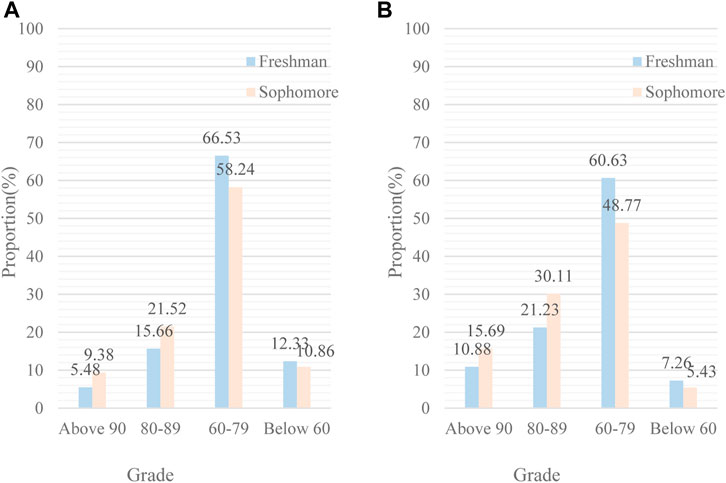
FIGURE 4. Physical health test grades of freshmen and sophomores in two schools. (A): School A based on the traditional intelligent supervision platform of physical health. (B): School B of the intelligent supervision platform for physical health based on intelligent medical service decision-making.
From Figures 4A, B, the percentage of excellent students in the physical fitness test in Figure 4A is lower than that in Figure 4B, but the percentage of unqualified students is higher than that in Figure 4B. The overall situation of students’ physical fitness test under this system is better than that under the traditional way. The test excellence level of freshmen under this system is 5.4% higher than that of traditional students. The sophomore’s test excellent grade is 6.31% higher than the traditional one. This means that the intelligent supervision platform of college students’ physical health for intelligent medical service decision-making built in this paper has more obvious effect on improving students’ overall physical fitness test results, and has better effect on improving students’ physical health.
3.2.2 Physical fitness results
Physical fitness covers five qualities: speed, strength, endurance, agility and flexibility. It is an important indicator to measure the strength of human body. The excellent grades of physical fitness of freshmen and sophomores in both ways are shown in Figure 5.
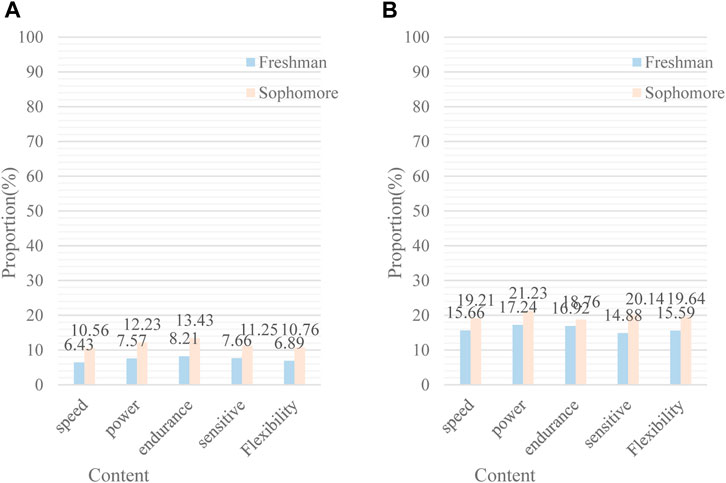
FIGURE 5. Comparison of excellent grades of students’ physical fitness in two ways. (A): Grade of excellent physical fitness of students in School A under the traditional way. (B): Grade of excellent physical fitness of students in School B in this way.
From Figures 5A, B, college students who build the system based on this method account for more excellent grades in various aspects of physical fitness tests than students in the traditional way. It suggests that the method of this study is beneficial in promoting the improvement of physical fitness of university students. However, the proportion of excellent grades can also reflect a problem, that is, the proportion of excellent grades in college students’ physical fitness test is low as a whole. This shows that although the intelligent supervision platform for college students’ physical health based on intelligent medical service decision-making can help students improve their physical quality and better play the role of school infrastructure, the overall physical quality of college students still needs to be improved. The proportion of students who failed in the physical fitness test is shown in Figure 6.
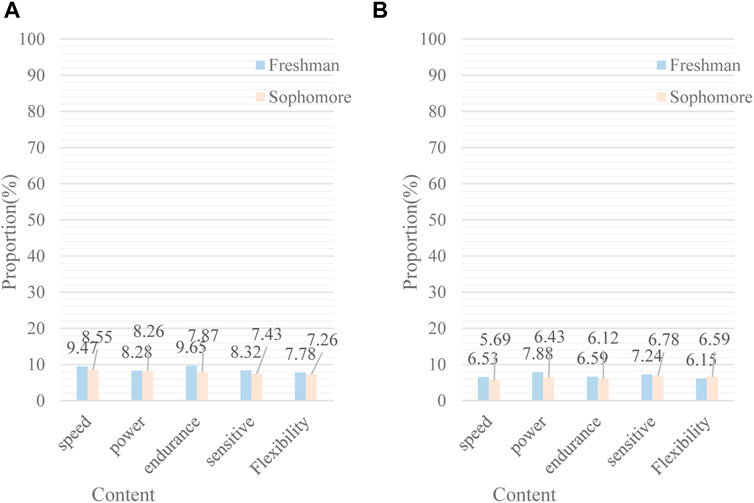
FIGURE 6. The proportion of students who failed the physical fitness test in two ways. (A): The proportion of students in School A who are not qualified in physical quality under the traditional way. (B): The proportion of students in School B who are not qualified in physical quality in this way.
It can be seen from Figures 6A, B that although the proportion of students with physical fitness disqualification under this method is lower than that under the traditional method, on the whole, the proportion of students with physical fitness disqualification is higher both in the traditional method and in the intelligent supervision platform for college students’ physical fitness built by this method. This shows that the physical quality of university students is not qualified is a more common situation must be paid attention to. Further research is needed regarding the improvement of physical fitness levels of college students.
3.2.3 Comparison of physical health monitoring
In addition to the comparison of the physical fitness test and physical fitness of students, this paper also compares the real-time monitoring of the physical fitness of college students by the physical fitness intelligent service system in two ways, and the comprehensiveness of the full time monitoring of sports. The scientific nature of illness healthcare management for students in higher education and the adaptability of dynamically adjusting exercise content give a comparison. The specific results are shown in Figure 7.
It can be seen from the above Figure 7 that the overall performance of the intelligent supervision platform for college students’ physical health based on this method is better than that of the traditional method, and its real-time monitoring of college students’ physical health dynamic state is 14.64% higher than that of the traditional method; The comprehensiveness of the whole-time monitoring of sports is 8.55% higher than that of the tradition, the scientificity of the disease and health management of college students is 10.6% higher than that of the tradition, and the flexibility of the dynamic adjustment of physical exercise content is 6.88% higher than that of the tradition. It can be seen that the intelligent supervision platform for college students’ physique and health, which is used for intelligent medical service decision-making, not only helps to improve the overall physique test and physical fitness of college students, but also has better performance than traditional methods in other aspects, and is more conducive to college students’ physique and health monitoring, comprehensive and timely understanding of college students’ physique, and accurate improvement of college students’ physique.
To sum up, through empirical research on the intelligent supervision platform of college students’ physical health for intelligent medical service decision-making, it is found that, the results show that the method has a good effect on improving the physical fitness of university students. Under this system, the test excellence level of freshmen is 5.4% higher than that of traditional students, and the test excellence level of sophomores is 6.31% higher than that of traditional students. Compared to the traditional ways, the proportion of excellent grades in the physical fitness test of university students is higher, which is more conducive to the improvement of university students’ physical quality. In addition, the physical fitness intelligent service system constructed by this method is also better than traditional methods in other aspects. Compared with the traditional way, the real-time monitoring of the dynamic condition of university students’ physical fitness is 14.64% higher, and the comprehensive monitoring of the whole period of sports is 8.55% higher. The scientific nature of disease health management is 10.6% higher, the degree of flexibility of dynamically adjusting sports content is 6.88% higher. The intelligent supervision platform of college students’ physical health for intelligent medical service decision-making based on machine learning of medical applications and high-performance computing can more intuitively monitor students’ physical, sports and psychological changes through emerging technologies, thus promoting personalized sports for each student and promoting the improvement of students’ physical health.
4 Conclusion
With the rapid development of economy and technology, machine learning and high-performance computing in medical applications have also been developed, the impact of medical applications on daily life is increasing. At the same time, due to the growing demand for talents in colleges and universities, college graduates have become an important force in the new era. The issue of university students’ physical fitness is also gaining more and more attention. This paper first gives a brief introduction to the research background of the article, then summarizes the previous scholars’ research, and then puts forward the idea of using intelligent medical service decision-making to build an intelligent supervision platform for college students’ physical health through theoretical analysis, which is verified by experiments. The results show that the platform can better understand the physical health of college students and provide personalized services for college students’ sports activities. Accurately improve the physical health level of college students and better handle the decline of college students’ physical health. Through the research on the physical fitness of university students, this paper showed that the physical fitness and sports of university students could be monitored in real time through the current information technology. At the same time, a service platform can be created to serve students’ scientific physical exercise and ultimately achieve the goal of achieving students’ physical fitness.
Data availability statement
The original contributions presented in the study are included in the article/supplementary material, further inquiries can be directed to the corresponding author.
Author contributions
The author confirms being the sole contributor of this work and has approved it for publication.
Funding
This work was supported by the 2021 special annual project of the China Association of Higher Education “Research on sports representation and realization path of university function” (No. 21TYZD05).
Conflict of interest
The author declares that the research was conducted in the absence of any commercial or financial relationships that could be construed as a potential conflict of interest.
Publisher’s note
All claims expressed in this article are solely those of the authors and do not necessarily represent those of their affiliated organizations, or those of the publisher, the editors and the reviewers. Any product that may be evaluated in this article, or claim that may be made by its manufacturer, is not guaranteed or endorsed by the publisher.
References
1. Moon JE. A convergence study on factors affecting physical-health status of college students. J Korea Convergence Soc (2018) 9:31–9. doi:10.15207/JKCS.2018.9.1.031
2. Barnett TM, McFarland A, Miller JW, Lowe V, Hatcher SS. Physical and mental health experiences among African American college students. Soc Work Public Health (2019) 34:145–57. doi:10.1080/19371918.2019.1575308
3. Chen X, Cui J, Zhang Y, Peng W. The association between BMI and health-related physical fitness among Chinese college students: A cross-sectional study. BMC Public Health (2020) 20:444–7. doi:10.1186/s12889-020-08517-8
4. Wang JL. The association between physical fitness and physical activity among Chinese college students. J Am Coll Health (2019) 67(6):602–9. doi:10.1080/07448481.2018.1515747
5. Kashuba V. Modern approaches to improving body constitution of female students within physical education classes. J Phys Educ Sport (2017) 17:2472–6. doi:10.7752/jpes.2017.04277
6. Snyder M, Zhou W. Big data and health. The Lancet Digital Health (2019) 1:252–4. doi:10.1016/s2589-7500(19)30109-8
7. Mirzaev AM. Improving tne physical fitness of students through the conduct of individual programs. Turkish J Comp Math Educ Turcomat (2021) 12:7054–5.
8. Vikawati NE, Sarosa H, Rosdiana I. The physical fitness evaluation of medical student in semarang: A cross sectional study. Bangladesh J Med Sci (2021) 20(2021):625–30. doi:10.3329/bjms.v20i3.52805
9. Zhai X, Ye M, Gu Q, Huang T, Wang K, Chen Z, et al. The relationship between physical fitness and academic performance among Chinese college students. J Am Coll Health (2022) 70(2022):395–403. doi:10.1080/07448481.2020.1751643
10. Demir F, Bajaj V, Ince MC, Taran S, Şengür A. Surface EMG signals and deep transfer learning-based physical action classification. Neural Comput Applic (2019) 31:8455–62. doi:10.1007/s00521-019-04553-7
11. Chen W, Hammond-Bennett A, Hypnar A, Mason S. Health-related physical fitness and physical activity in elementary school students. BMC public health (2018) 18:195–12. doi:10.1186/s12889-018-5107-4
12. Winter A, Stäubert S, Ammon D, Aiche S, Beyan O, Bischoff V, et al. Smart medical information technology for healthcare (SMITH). Methods Inf Med (2018) 57:92–105. doi:10.3414/ME18-02-0004
13. Ren S, Jain DK, Guo K, Xu T, Chi T. Towards efficient medical lesion image super-resolution based on deep residual networks. Signal Process Image Commun (2019) 75:1–10. doi:10.1016/j.image.2019.03.008
14. Kozimjanovich AK. Increasing the physical fitness of students in the system of higher pedagogical education. Pioneer: J Adv Res Scientific Prog (2022) 1:54–7.
Keywords: college students physical health, intelligent medical service decision-making, clustering algorithm, sports culture, smart security service system
Citation: Guo F (2023) Construction of intelligent supervision platform for college students’ physical health for intelligent medical service decision-making. Front. Phys. 11:1170585. doi: 10.3389/fphy.2023.1170585
Received: 21 February 2023; Accepted: 19 June 2023;
Published: 20 July 2023.
Edited by:
Amrit Mukherjee, University of South Bohemia in České Budějovice, CzechiaReviewed by:
Cui Yong, Southwest Petroleum University, ChinaTiefeng Wu, Qingdao University of Technology, China
Copyright © 2023 Guo. This is an open-access article distributed under the terms of the Creative Commons Attribution License (CC BY). The use, distribution or reproduction in other forums is permitted, provided the original author(s) and the copyright owner(s) are credited and that the original publication in this journal is cited, in accordance with accepted academic practice. No use, distribution or reproduction is permitted which does not comply with these terms.
*Correspondence: Fei Guo, Z3VvZmVpQGhyYnUuZWR1LmNu
 Fei Guo
Fei Guo